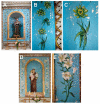Botanical Analysis of the Baroque Art on the Eastern Adriatic Coast, South Croatia
- PMID: 37299059
- PMCID: PMC10255097
- DOI: 10.3390/plants12112080
Botanical Analysis of the Baroque Art on the Eastern Adriatic Coast, South Croatia
Abstract
The analysis of plants featured in Baroque artworks on the eastern Adriatic coast has not previously been the subject of an in-depth study. The study of plant iconography in Baroque sacred artworks, which are mostly paintings, was carried out in eight churches and monasteries on the Pelješac peninsula in southern Croatia. Taxonomic interpretation of the painted flora on 15 artworks led to the identification of 23 different plant taxa (species or genera) belonging to 17 families. One additional plant was identified only by family taxonomic rank. The number of plants was relatively high, and most species were considered non-native (71%, "exotic" flora) phanerophytes. In terms of geographic origin, the Palaearctic region (Eurasia) and the American continent were identified as the main areas of plant origin. Lilium candidum, Acanthus mollis, and Chrysanthemum cf. morifolium, were the most common species. We think that the plants were selected for decorative and aesthetic reasons, as well as for their symbolic significance.
Keywords: Baroque; NE Mediterranean; Pelješac peninsula; art; floral elements; sacral heritage.
Conflict of interest statement
The authors declare no conflict of interest.
Figures





Similar articles
-
Hydroids (Cnidaria, Hydrozoa) from Mauritanian Coral Mounds.Zootaxa. 2020 Nov 16;4878(3):zootaxa.4878.3.2. doi: 10.11646/zootaxa.4878.3.2. Zootaxa. 2020. PMID: 33311142
-
Analysis of floristic composition and species diversity of vascular plants native to the State of Palestine (West Bank and Gaza Strip).Biodivers Data J. 2022 May 19;10:e80427. doi: 10.3897/BDJ.10.e80427. eCollection 2022. Biodivers Data J. 2022. PMID: 36761642 Free PMC article.
-
FIVE DEPICTIONS OF THE CIRCUMCISION OF JESUS CHRIST FROM THE CROATIAN SACRAL HERITAGE.Acta Med Hist Adriat. 2021 Jun 17;19(1):19-32. doi: 10.31952/amha.19.1.1. Acta Med Hist Adriat. 2021. PMID: 35212204
-
Plant reproductive ecology and evolution in the Mediterranean islands: state of the art.Plant Biol (Stuttg). 2018 Jan;20 Suppl 1:63-77. doi: 10.1111/plb.12636. Epub 2017 Oct 29. Plant Biol (Stuttg). 2018. PMID: 28945322 Review.
-
Medicinal Plants Used Traditionally for Skin Related Problems in the South Balkan and East Mediterranean Region-A Review.Front Pharmacol. 2022 Jul 5;13:936047. doi: 10.3389/fphar.2022.936047. eCollection 2022. Front Pharmacol. 2022. PMID: 35865952 Free PMC article. Review.
Cited by
-
Historical Ethnobotany: Interpreting the Old Records.Plants (Basel). 2023 Oct 25;12(21):3673. doi: 10.3390/plants12213673. Plants (Basel). 2023. PMID: 37960030 Free PMC article.
References
-
- Flora Croatica Database. [(accessed on 24 November 2022)]. Available online: http://hirc.botanic.hr/fcd.
-
- Kumbaric A., Caneva G. Updated outline of floristic richness in Roman iconography. Rend. Lincei Sci. Fis. Nat. 2014;25:181–193. doi: 10.1007/s12210-013-0279-4. - DOI
-
- Caneva G., Altieri A., Kumbaric A., Bartoli F. Plant iconography and its message: Realism and symbolic message in the Bernini fountain of the four rivers in Rome. Rend. Lincei Sci. Fis. Nat. 2020;31:1011–1026. doi: 10.1007/s12210-020-00946-2. - DOI
-
- Hosseini Z., Caneva G. Lost gardens: From knowledge to revitalization and cultural valorization of natural elements. Sustainability. 2022;14:2956. doi: 10.3390/su14052956. - DOI
-
- Rivera D., Obón C., Alcaraz F., Laguna E., Johnson D. Date-palm (Phoenix, Arecaceae) iconography in coins from the Mediterranean and West Asia (485 BC–1189 AD) J. Cult. Herit. 2019;37:199–214. doi: 10.1016/j.culher.2018.10.010. - DOI
LinkOut - more resources
Full Text Sources

